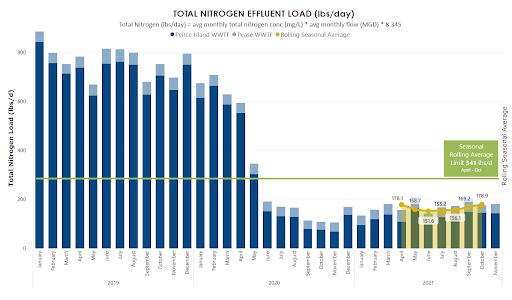The Challenge
The Peirce Island Wastewater Treatment Facility (WWTF) had a secondary NPDES Permit in 2007. The City had objectives to meet future more stringent permit limits but also address the following challenges. First, the WWTF has significant space constraints, as it is located at the tip of the island. Secondly, the technology needed to achieve TN removal to a future concentration of 3 mg/L. Thirdly, the technology needed to help increase the plant capacity from 4.8 MGD to 6.1 MGD while being able to handle a peak flow of 22 MGD. Fourth, the technology had to be able to help the plant minimize future capital upgrades. Fifth, the technology needed to have a proven operational track record. Last but not least, factors such as health & safety, ease of operation, responses to process disruption, etc. needed to be considered when selecting a solution.
After studying a long list of technologies (including BIOSTYR® BAF, MBBR & DAF, MBR, SBR & Ballasted processes, MBBR & ballasted clarification, CAS & ballasted clarification), the City piloted three technologies: Veolia’s BIOSTYR® BAF, ballasted conventional activated sludge, and MBBR + DAF.
The Solution
Based on pilot performance, expertise and a comprehensive technology priority matrix, the City was convinced that BIOSTYR® was the best option to address all of the challenges and meet all of the City’s goals.
Process Description
The new treatment system includes raw wastewater screening (new), aerated grit removal, primary clarification (CEPT during wet weather events), two-stage BIOSTYR® BAF, disinfection with liquid chlorine, and dechlorination. Stage 1 of the BIOSTYR® has six cells for BOD and TSS removal and nitrification. Stage 2 of the BIOSTYR® also has six cells for denitrification. The system is designed to meet a CBOD5 limit of less than 30 mg/L, a TSS limit of less than 30 mg/L, and a future TN limit of less than 3 mg/L.
Results
The BIOSTYR® system was commissioned in December 2019. Since startup, the effluent BOD and TSS concentrations, on average, have been around 10 mg/L each. During winter with the colder water temperatures, the system achieved complete nitrification within several months without nitrifier seeding. Process performance testing was successfully completed to meet the future TN limit of 3.0 mg/L. Since the City is not required to meet that concentration by permit,
they operate with reduced consumption of supplemental carbon so that the effluent TN varies between approximately 3 and 5 mg/L with an average of 4 mg/L, which has enabled the plant to consistently meet a seasonal rolling average limit of 341 lbs/day TN discharge.

The Client
The City of Portsmouth is a historic tourist destination located on the seacoast of New Hampshire. It has access to various waterways and provides service to over 90% of the City’s developed land area, including the Pease International Tradeport.
Key Benefits
- Space constraints addressed
- Eliminating the need for secondary clarifiers
- High level of automation
- Lower level of operating skills required
- Significantly reduced odor potential for surrounding recreational areas
- Future capital upgrades minimized
- Nitrogen removal performance allows for credit


